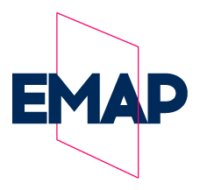Two exhibitions of new work emerging from recent artists’ residencies organised across Europe by the European Media Art Platform (EMAP).

Oceans 4.0
Marco Barotti, Anna Dumitriu and Alex May, Robertina Šebjanič and Gjino Šutić
Our focus for 2020 is the environmental challenge facing our planet. Oceans 4.0 presents three projects that monitor, reflect and imagine the future of our threatened oceans.
In nature, clams are detectors of pollutants; they serve as tiny filtration systems. Inspired by this natural phenomenon, Marco Barotti presents his new work Clams, a kinetic sound installation triggered by water quality. Live data is streamed by a sensor placed into the ocean and converted into an audio signal. Barotti’s clam sculptures - made from recycled industrial plastic waste - are triggered by this signal, generating an evolving soundscape, creating an experience that allows us to see and hear water quality in real-time.
How do the oceans feel our impact? Robertina Šebjanič and Gjino Šutić’s aqua_forensic illuminates invisible pollutants, residues of human consumption, and ‘monsters’ in our waters. Documenting the artists’ ‘in vitro’ experiments, the project shows microorganisms dying in weak solutions of pharmaceuticals - 20,000 times weaker than the average human dose. Interrogating the negative impact we are having on water habitats and lifeforms, aqua_forensic questions our solidarity and empathy with water systems beyond our human perception.
What will ‘life’ mean in a post-climate change future? Anna Dumitriu & Alex May’s ArchaeaBot: A Post Singularity and Post Climate Change Life-form (2018-19) is an underwater robotic installation based on new research on archaea: a group of micro-organisms believed to be the oldest form of life on earth, adapted to live in extreme conditions. Combined with the latest innovations in artificial intelligence and machine learning, the artists have tried to create the ultimate species for the end of the world.







no bodies welcome | all bodies welcome
Aay Liparoto with HOT BODIES - CHOIR
no bodies welcome | all bodies welcome is a speculative choir piece housed within a ‘void pod’, by Aay Liparoto, FACT’s 2019 EMAP artist-in-residence. In their work, Liparoto acknowledges our interdependence with technology for information, work, sex, entertainment, communication, socialising, banking, healthcare and the crossovers in between. What does this web of interdependence mean for queer feminist bodies which rely heavily on more DIY information exchange? no bodies welcome | all bodies welcome invites us to question the politics and power of the spaces we participate in online, and the behaviour of ourselves and others within them via the ‘void pod’. Housing a new sound piece created through workshops with HOT BODIES – CHOIR a queer, LGBTIEA+ and feminist choir based in Brussels. In the pod, cocooned with light and sound, their voices invite us to reflect and question these spaces and behaviours.
Liparoto’s artwork has been informed by their ongoing research Not Found On, part of which they carried out during their residency, where they held workshops across Liverpool with the aim to dicuss the co-creation of an online knowledge bank with, by and for feminist queer bodies to record and exchange community knowledge.
no bodies welcome | all bodies welcome and Oceans 4.0 is part of the European Media Art Platform / European Media Artists in Residence Exchange programme, co-funded by the Creative Europe Programme of the European Union.
no bodies welcome | all bodies welcome is supported through an EMAP/EMARE artist’s residency at FACT in Liverpool, UK.
Clams is supported through an EMAP/EMARE artist’s residency at WRO Center for Media Art Foundation in Wrocław, Poland.
aqua_forensic is supported through an EMAP/EMARE artists’ residency at Ars Electronica in Linz, Austria.
ArchaeaBot by Anna Dumitriu and Alex May was made in collaboration with researcher/cryomicroscopist Amanda Wilson as part of the EU FET Open H2020 funded MARA project based in the Beeby Lab at Imperial College London, and with Professor Daniel Polani from the School of Computer Science at the University of Hertfordshire. The project is supported through an EMAP/EMARE artists’ residency at LABoral Centro de Arte y Creación Industrial in Gijón, Spain and with generous support from Arts Council England.
Clams (2019)
In nature, clams are detectors of pollutants; they serve as tiny filtration systems. Inspired by this natural phenomenon, Marco Barotti is now presenting his new work Clams, a kinetic sound installation triggered by water quality.
aqua_forensic (2019)
*aqua_forensic* illuminates the invisible anthropogenic pollutants in water habitats.
ArchaeaBot: A Post Singularity and Post Climate Change Life-form (2019)
ArchaeaBot: A Post Singularity and Post Climate Change Life-form takes the form of an underwater robotic installation that explores what ‘life’ might mean in a post singularity, post climate change future.
no bodies welcome | all bodies welcome (2019)
no bodies welcome | all bodies welcome is a speculative choir piece housed within a ‘void pod’, by Aay Liparoto, FACT’s 2019 EMAP artist-in-residence.
by Aay Liparoto
Call for Applications – Residencies for European media artists in 2020 and 2021
The European Media Art Platform will offer EMARE (European Media Artist in Residence Exchange) residencies for artists working in the fields of digital media – in internet and computer-based arts, in sound or video art, in media-based performance, as well as in robotics or bio-art.
by FACT
Supporters


Be inspired
Stay in touch
Join our mailing list and get the latest news about exhibitions, events, cinema highlights and opportunities sent to your inbox.
Sign me up





